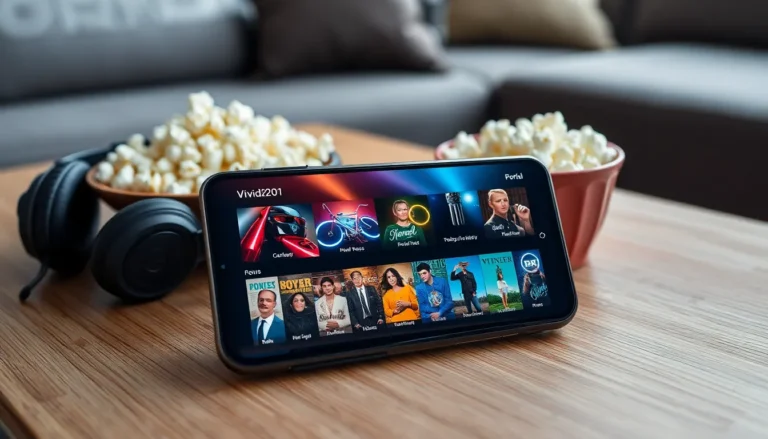In a world where your refrigerator can remind you to buy milk and your thermostat knows when you’re too hot to handle, IoT smart solutions are revolutionizing everyday life. Imagine a home that anticipates your needs, making you feel like a tech-savvy wizard. With the Internet of Things, mundane tasks become a breeze, and the future feels just a little bit closer—minus the flying cars, of course.
These smart solutions aren’t just about convenience; they’re about transforming how people interact with their environments. From energy-efficient appliances to security systems that can outsmart even the craftiest burglars, IoT is changing the game. So buckle up and get ready to explore how these innovations can make life easier, safer, and maybe even a little more fun. After all, who wouldn’t want a home that can do the thinking for them?
Table of Contents
ToggleOverview of IoT Smart Solutions
IoT smart solutions revolutionize how individuals interact with their spaces. These systems seamlessly integrate with daily routines, improving efficiency and convenience. Smart homes equipped with IoT devices can anticipate needs, adjusting lighting, temperature, and security automatically. Energy-efficient appliances play a crucial role by optimizing usage and reducing consumption, leading to lower utility bills.
Advanced security systems designed with IoT capabilities offer enhanced monitoring and real-time alerts. Cameras and sensors provide peace of mind, knowing that they can detect unusual activity and alert homeowners. Smart locks add another layer of protection, enabling remote access control for users.
In addition to safety features, IoT solutions elevate the enjoyment of everyday activities. Automated systems can manage entertainment devices, allowing users to control music and video settings easily through voice commands or apps. This integration transforms how families engage with technology, making experiences more immersive.
Healthcare is another significant area benefiting from IoT smart solutions. Wearable devices monitor health metrics, sending data to healthcare providers for better management of chronic conditions. This capability encourages proactive health measures, promoting a healthier lifestyle.
Businesses also leverage IoT technology for operational efficiencies. Inventory management systems equipped with sensors track stock levels, minimizing waste and ensuring timely restocking. Employees benefit from improved workflows through connected devices that streamline processes.
The ongoing development in IoT promotes a future where environments respond dynamically to human activities. As more devices connect, they create a more interactive and intuitive experience, making daily life smoother and more enjoyable.
Key Components of IoT Smart Solutions

IoT smart solutions rely on various key components to function effectively. Understanding these components is essential for grasping the full potential of IoT technologies.
Sensors and Devices
Sensors are the backbone of IoT smart solutions. They collect data on various parameters, including temperature, humidity, and movement. Devices equipped with sensors enable automation by providing real-time information, influencing decision-making. Examples include smart thermostats that adjust heating based on occupancy and motion sensors that enhance security. Consequently, these devices create a responsive environment that adapts to users’ needs, improving overall comfort and efficiency.
Connectivity and Communication Protocols
Connectivity ensures seamless communication between devices. Various protocols facilitate this exchange, including Wi-Fi, Bluetooth, Zigbee, and LoRaWAN. Each technology offers distinct advantages, such as range, power consumption, and data transfer speeds. Choosing the right protocol depends on factors like application requirements and environmental conditions. Enhanced connectivity promotes interoperability among devices, enabling a cohesive smart ecosystem. As a result, users benefit from a unified experience where devices communicate effortlessly.
Data Processing and Analytics
Data processing plays a crucial role in transforming raw data into actionable insights. IoT devices generate large volumes of information, necessitating robust analytics tools. Real-time analytics allow for timely responses to emerging trends and anomalies. Cloud computing often supports these processes by offering scalable storage and processing power. Advanced algorithms can identify patterns, leading to more informed decisions and improved operational efficiency. Ensuring effective data processing enhances the overall functionality of IoT smart solutions.
Applications of IoT Smart Solutions
IoT smart solutions find applications across various sectors, significantly improving efficiency, convenience, and quality of life.
Home Automation
Home automation enhances comfort and security. Smart devices control lighting, heating, and appliances seamlessly. Homeowners can adjust settings remotely through mobile applications. Automated systems learn from user behaviors, optimizing energy use. Advanced security features, such as smart locks and surveillance cameras, offer real-time monitoring. With voice-activated assistants, managing daily tasks becomes effortless. Routine scheduling simplifies energy consumption, leading to lower utility costs and increased convenience. Overall, IoT transforms homes into responsive environments.
Healthcare Innovations
In healthcare, IoT smart solutions drive patient care enhancements. Wearable devices track health metrics like heart rate and activity levels. Real-time data enables proactive health interventions. Telehealth services benefit from IoT, allowing doctors to monitor patients remotely. Smart devices improve medication adherence through reminders. Remote diagnostics and data sharing enhance patient-provider communication. Hospital environments utilize IoT for asset tracking and patient management, increasing operational efficiency. Consequently, smart solutions promote a healthier lifestyle and improved health outcomes.
Smart Cities and Infrastructure
Smart cities leverage IoT to improve urban living conditions. Traffic management systems use real-time data for optimizing flow and reducing congestion. Waste management solutions monitor containers, scheduling pickups efficiently. Public safety improves through smart surveillance and emergency response systems. Resource management encompasses energy and water conservation, reducing environmental impact. Citizens gain access to smart public services, enhancing their overall quality of life. By integrating technology into infrastructure, cities become more sustainable and livable.
Benefits of Implementing IoT Smart Solutions
Implementing IoT smart solutions offers numerous advantages across various domains. Enhanced convenience stands out as one of the most significant benefits. Smart homes can automate mundane tasks, adjusting lighting and temperature effortlessly. Users achieve greater comfort with just a few taps on their devices.
Improved energy efficiency plays a crucial role in reducing utility costs. Advanced appliances optimize energy consumption based on real-time data. Homeowners experience lower bills while minimizing their environmental footprint.
Advanced security systems provide an essential layer of protection. Real-time monitoring and alerts help ensure peace of mind for residents. Homeowners can access and control security features remotely, creating a safer living environment.
In healthcare, wearable devices enhance patient care significantly. Health metrics monitored continuously enable proactive management of conditions. Providers benefit from real-time health data, facilitating timely interventions and better outcomes.
Operational efficiencies gain importance in business settings. IoT technology streamlines inventory management and workflow processes. Companies can access insights that lead to improved decision-making and resource utilization.
Smart cities illustrate the broader impact of IoT solutions. Optimized traffic management reduces congestion and improves commutes. Sustainable waste collection and resource conservation initiatives enhance urban living conditions.
Enhanced entertainment experiences also present a valuable benefit. IoT solutions integrate seamlessly with various devices, allowing voice control and app management. Users enjoy effortless access to their favorite media and devices whenever they desire.
The implementation of IoT smart solutions results in enhanced convenience, energy efficiency, safety, healthcare improvements, business efficiencies, urban enhancements, and entertainment integration. These benefits collectively contribute to a more connected and efficient lifestyle.
Challenges and Considerations
Implementing IoT smart solutions presents several challenges that require careful consideration. Security risks stand out, as connected devices can become vulnerable to cyberattacks. Encrypting data and using secure communication protocols mitigate these risks, but remain essential practices for developers.
Data privacy represents another significant concern. Consumers often worry about how their personal information is collected and used. Companies must adopt transparent data policies to build trust and ensure compliance with regulations like GDPR.
Interoperability across devices complicates integration. Many manufacturers design products with proprietary technologies, leading to compatibility issues. Standardizing communication protocols promotes seamless interactions among various IoT devices, enhancing user experience.
Furthermore, scaling IoT solutions can prove difficult for organizations. Expanding systems may involve notable costs and resource demands, impacting budgeting and planning. Choosing the right platforms to facilitate growth offers an effective strategy.
Network reliability also plays a critical role in the effectiveness of IoT smart solutions. Weak connections may lead to lost data or device malfunctions. Investing in robust network infrastructure and redundant systems ensures consistent performance.
Lastly, user adoption remains an essential factor. Some individuals may resist adopting new technologies due to a lack of understanding or perceived complexity. Educating users about the benefits of IoT solutions fosters engagement and encourages broader acceptance.
Addressing these challenges is vital for the successful integration of IoT smart solutions in daily life. By focusing on security, privacy, interoperability, scalability, network reliability, and user adoption, stakeholders can develop effective and user-friendly systems.
Embracing IoT smart solutions is reshaping the way people interact with their environments. These innovations not only enhance convenience but also elevate safety and energy efficiency. As technology continues to evolve, homes and businesses will become increasingly responsive to individual needs.
While the benefits are significant, addressing security and interoperability challenges is essential for widespread adoption. Organizations must prioritize robust security measures and user education to build trust in these systems.
Ultimately, the future of IoT promises a more connected and intuitive lifestyle where technology seamlessly integrates into daily routines, making life easier and more enjoyable for everyone.


